. The soil, its nature, relations, and fundamental principles of management . am even after it passes the city of Memphis;and vast as this work can but be, it must constitute astandard all too small by which to measure that whichin the aggregate is done throughout the broad valley ofthe Ohio, the Upper Mississippi, and the Missouri, withtheir tributaries. Glance for a moment at Fig. 9 thatit may be realized, not only how many times the Madisonfork of the Missouri River must have crossed and re-crossed its broad valley, but how many times over andover again it must have handled that soil before

Image details
Contributor:
Reading Room 2020 / Alamy Stock PhotoImage ID:
2CGHNXDFile size:
7.1 MB (601.7 KB Compressed download)Releases:
Model - no | Property - noDo I need a release?Dimensions:
1178 x 2121 px | 19.9 x 35.9 cm | 7.9 x 14.1 inches | 150dpiMore information:
This image is a public domain image, which means either that copyright has expired in the image or the copyright holder has waived their copyright. Alamy charges you a fee for access to the high resolution copy of the image.
This image could have imperfections as it’s either historical or reportage.
. The soil, its nature, relations, and fundamental principles of management . am even after it passes the city of Memphis;and vast as this work can but be, it must constitute astandard all too small by which to measure that whichin the aggregate is done throughout the broad valley ofthe Ohio, the Upper Mississippi, and the Missouri, withtheir tributaries. Glance for a moment at Fig. 9 thatit may be realized, not only how many times the Madisonfork of the Missouri River must have crossed and re-crossed its broad valley, but how many times over andover again it must have handled that soil before it suc-ceeded in carrying out of its field of labor the amountwhich the unimpeachable testimony of those terracesshow it has transported to lower levels. Think alsohow, again and again, a new vegetation must havetaken possession of the reworked land, as the soil wasbeing transferred now to the right bank and now to theleft. Years and years, and even centuries, must havepassed before a given field was entirely replowed, resoiled, and reseeded; but everywhere in the past and. art ao PC o .£3CO 6 50 The Soil everywhere in the present this long-time rotation hasbeen and is now being carried on by the ceaseless actionof rivers. WORK OF RAIN. Besides the action upon the soil, of running water, which we have considered, after it has reached theperennial waterways, there is a large mechanical workperformed by the rain while on its way over the surfacetoward the streams or before entering the ground toemerge again in the form of springs. At the time ofheavy rains the surface of the ground, even on rathersteep slopes, becomes covered with a sheet of water, andthe raindrops, striking into this and upon the soil, workup the looser grains so that, as the water moves down theinclines, it bears along with it over shorter or longer dis-tances a considerable body of soil. In cultivated fields, especially where the soil has a fine texture and the prop-erty of losing its coherence when flooded wit